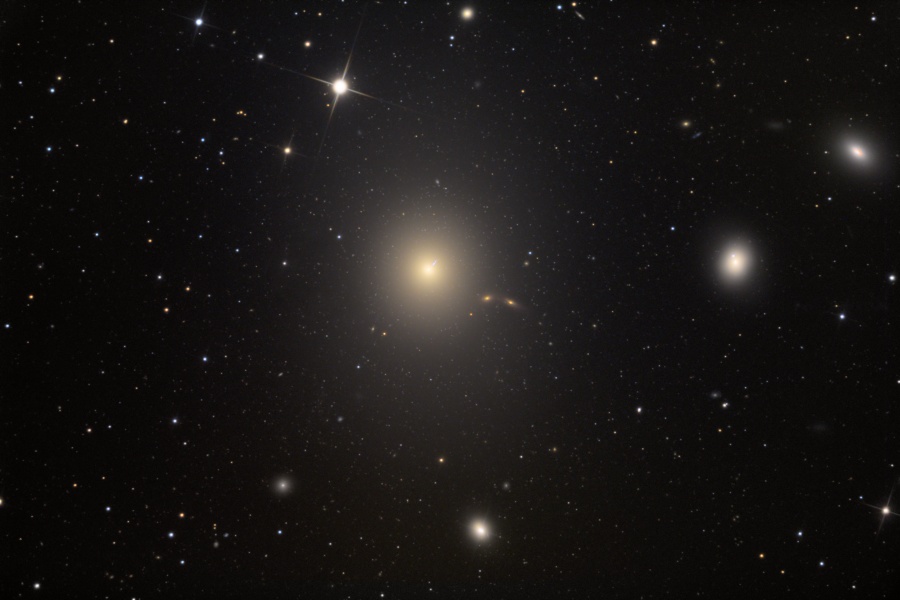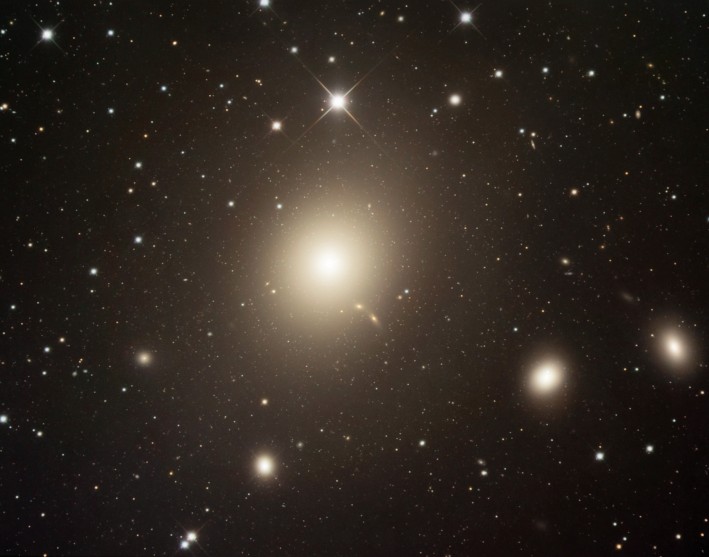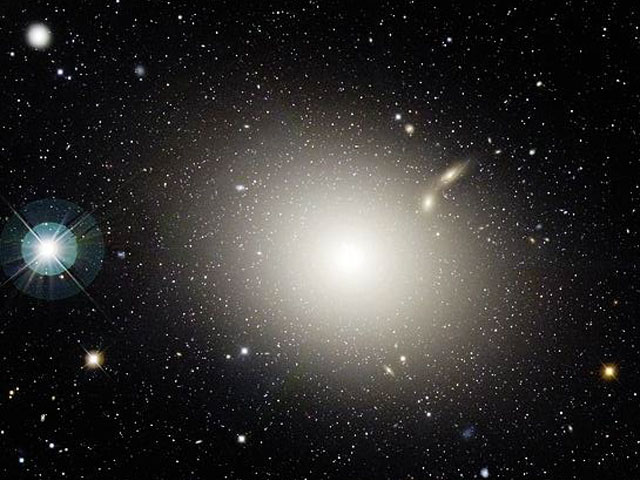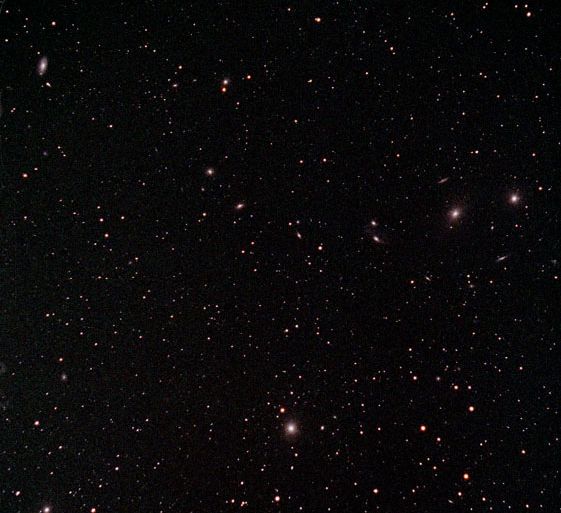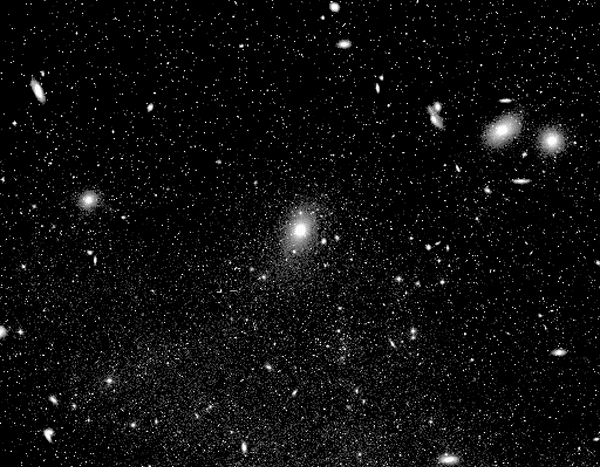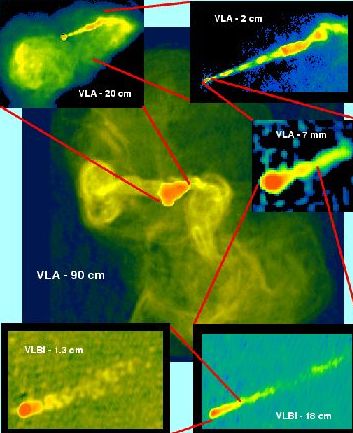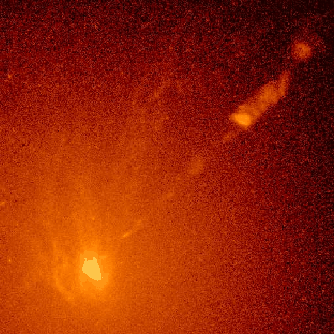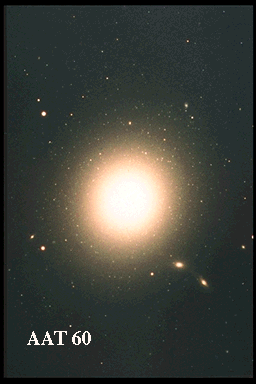Messier 87 / NGC 4486
All titles are clickable and link to the original APOD page. Click on an image for a larger view of it.
2011 April 22
[imghover6=http://apod.nasa.gov/apod/image/1104/20 ... reo900.jpg]http://apod.nasa.gov/apod/image/1104/20 ... 900lab.jpg[/imghover6]Image Credit & Copyright: Rogelio Bernal Andreo
2010 May 20 In spiral galaxies, majestic winding arms of young stars, gas, and dust rotate in a flat disk around a bulging galactic nucleus. But elliptical galaxies seem to be simpler. Lacking gas and dust to form new stars, their randomly swarming older stars, give them an ellipsoidal (egg-like) shape. Still, elliptical galaxies can be very large. Centered in this telescopic view and over 120,000 light-years in diameter, larger than our own Milky Way, elliptical galaxy M87 (NGC 4486) is the dominant galaxy of the Virgo Galaxy Cluster. Some 50 million light-years away, M87 is likely home to a supermassive black hole responsible for a high-energy jet of particles emerging from the giant galaxy's central region. In this well-processed image, M87's jet is near the one o'clock position. Other galaxies are also in the field of view, including large Virgo Cluster ellipticals NGC 4478 right of center and NGC 4476 near the right edge.
2006 May 20 In spiral galaxies, majestic winding arms of young stars and interstellar gas and dust rotate in a flat disk around a bulging galactic nucleus. But elliptical galaxies seem to be simpler. Lacking gas and dust to form new stars, their randomly swarming older stars, give them an ellipsoidal (egg-like) shape. Still, elliptical galaxies can be very large. Over 120,000 light-years in diameter (larger than our own Milky Way), elliptical galaxy M87 is the dominant galaxy at the center of the Virgo Galaxy Cluster, some 50 million light-years away. M87 is likely home to a supermassive black hole responsible for the high-energy jet of particles emerging from the giant galaxy's central region.
2005 March 16 Across the heart of the Virgo Cluster of Galaxies lies a striking string of galaxies known as Markarian's Chain. The chain, pictured above, is highlighted on the upper right with two large but featureless lenticular galaxies, M84 and M86, and connects to the large spiral on the lower left, M88. Prominent on the lower right but not part of Markarian's Chain is the giant elliptical galaxy M87. The home Virgo Cluster is the nearest cluster of galaxies, contains over 2000 galaxies, and has a noticeable gravitational pull on the galaxies of the Local Group of Galaxies surrounding our Milky Way Galaxy. The center of the Virgo Cluster is located about 70 million light years away toward the constellation of Virgo. At least seven galaxies in the chain appear to move coherently, although others appear to be superposed by chance.
2004 June 16 Elliptical galaxy M87 is a type of galaxy that looks much different than our own Milky Way Galaxy. Even for an elliptical galaxy, though, M87 is peculiar. M87 is much bigger than an average galaxy, appears near the center of a whole cluster of galaxies known as the Virgo Cluster, and shows an unusually high number of globular clusters. These globular clusters are visible as faint spots surrounding the bright center of M87. In general, elliptical galaxies contain similar numbers of stars as spiral galaxies, but are ellipsoidal in shape (spirals are mostly flat), have no spiral structure, and little gas and dust. The above image of M87 was taken recently by the Canada-France-Hawaii Telescope on top of the dormant volcano Mauna Kea in Hawaii, USA.
2001 November 1
2004 December 11
2001 January 26 Well over a thousand galaxies are known members of the Virgo Cluster, the closest large cluster of galaxies to our own local group. The galaxy cluster is difficult to see all at once because it covers such a large area on the sky. Still, this excellent telescopic view records the region of the Virgo Cluster around its dominant giant elliptical galaxy M87. M87 can be seen as a fuzzy patch near the picture's bottom center. In fact, a close examination of the image will reveal that many of the "stars" are actually surrounded by a telltale fuzz, indicating that they are Virgo Cluster galaxies. How many galaxies can you pick out? Click on the image for an uncropped, labeled version which includes the NGC catalog numbers for most of the visible galaxies. On average, Virgo Cluster galaxies are measured to be about 48 million light-years away. The Virgo Cluster distance has been used to give an important determination of the Hubble Constant and the scale of the Universe.
2000 July 6 What's causing a huge jet to emanate from the center of galaxy M87? Although the unusual jet was first noticed early in the twentieth century, the exact cause is still debated. The above recently released picture taken by the Hubble Space Telescope shows clear details, however. The most popular hypothesis holds that the jet is created by energetic gas swirling around a massive black hole at the galaxy's center. The result is a 5000 light-year long blowtorch where electrons are ejected outward at near light-speed, emitting eerily blue light during a magnetic spiral. M87 is a giant elliptical galaxy residing only 50 million light-years away in the Virgo Cluster of Galaxies. The faint dots of light surrounding M87's center are large ancient globular clusters of stars.
2000 February 20 Pictured are several galaxies of the Virgo Cluster, the closest cluster of galaxies to our Milky Way Galaxy. The Virgo Cluster spans more than 5 degrees on the sky - about 10 times the angle made by a full Moon. It contains over 100 galaxies of many types - including spirals, ellipticals, and irregular galaxies. The Virgo Cluster is so massive that it is noticeably pulling our Galaxy toward it. The cluster contains not only galaxies filled with stars but also gas so hot it glows in X-rays. Motions of galaxies in and around clusters indicate that they contain more dark matter than any visible matter we can see. Notable bright galaxies in the Virgo Cluster include bright Messier objects such as M61, M87, M90, and M100.
1999 February 16 The small core of elliptical galaxy M87 appears to be energizing its whole galactic neighborhood. Recent images from the Very Large Array (VLA) of radio telescopes indicate that huge bubbles of hot gas not only exist but are still being created. These bubbles measure 200,000 light-years across and surround the entire galaxy. The source creating and feeding the bubbles has been traced to jets pointing back to M87's center, where a supermassive black hole is thought to live. The smallest scale on the above radio-map is 0.2 light-years and imaged by many radio telescopes working together (VLBI). The labeled numbers refer to the wavelength of the radio waves observed. The exact composition of these jets is not known, but thought to contain various subatomic particles.
1996 April 19 This ROSAT image of the Virgo cluster of galaxies reveals a hot X-ray emitting plasma or gas with a temperature of 10-100 million degrees pervading the cluster. False colors have been used to represent the intensity of X-ray emission. The large area of X-ray emission, just below and left of center, is about 1 million light-years across. The giant elliptical galaxy M87, the biggest member of the cluster, is centered in that area while other cluster members are scattered around it. By adding up the amount of X-ray emitting gas astronomers have found that its total mass is up to 5 times the total mass of the cluster galaxies themselves - yet all this matter still does not produce nearly enough gravity to keep the cluster from flying apart! Where is the unseen mass? Because galaxy clusters are the largest structures in the Universe, this mysterious Dark Matter must dominate the cosmos but its nature is still an open question.
1996 March 5
1997 April 5 The center of nearby giant galaxy M87 is a dense and violent place. In this 1994 photograph by the Hubble Space Telescope, a disk of hot gas was found to be orbiting at the center of this massive elliptical galaxy. The disk is evident on the lower left of the above photograph. The rotation speed of gas in this disk indicates the mass of the object the gas is orbiting, while the size of the disk indicates an approximate volume of the central object. These observations yield a central density so high that the only hypothesized object that could live there is a black hole. The picture also shows a highly energetic jet emanating from the central object. The jet is composed of fast moving charged particles and has broken into knots as small as 10 light years across.
1995 September 13 Elliptical galaxy M87 is a type of galaxy that looks much different than our own Milky Way Galaxy. But even for an elliptical galaxy M87 is peculiar. M87 is much bigger than an average galaxy, appears at the center of a whole cluster of galaxies known as the Virgo Cluster, and shows a very high number of globular clusters. These globular clusters are visible as faint spots surrounding the bright center of M87. In general, elliptical galaxies contain similar numbers of stars as spiral galaxies, but are ellipsoidal in shape (spirals are mostly flat), have no spiral structure, and little gas and dust. This picture is number sixty on a publicly posted list of images from the Anglo-Australian Telescope (AAT).
